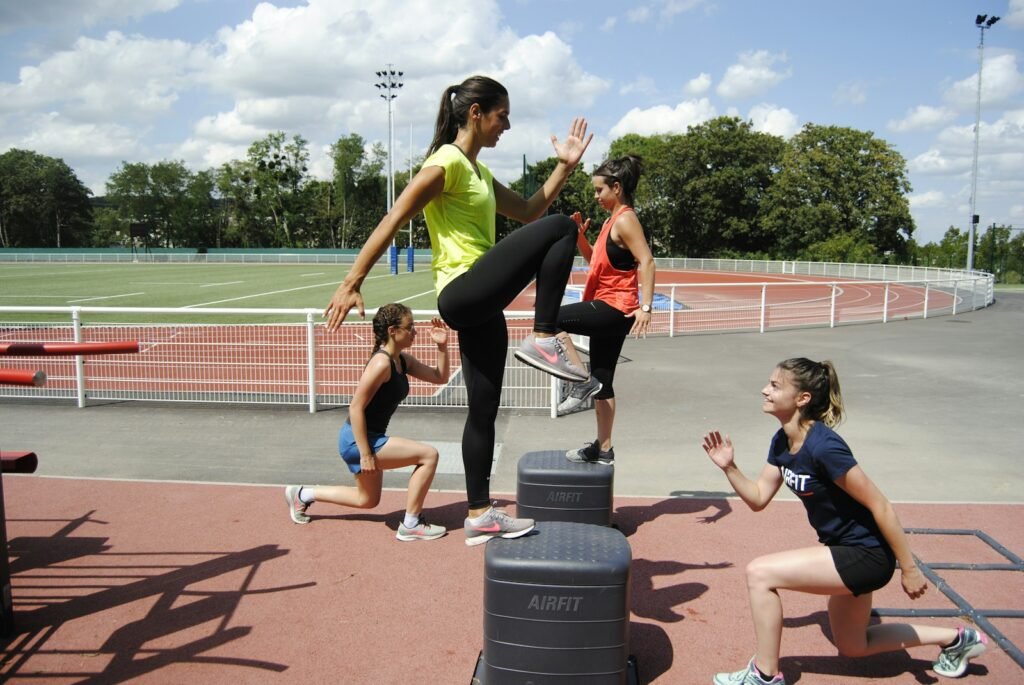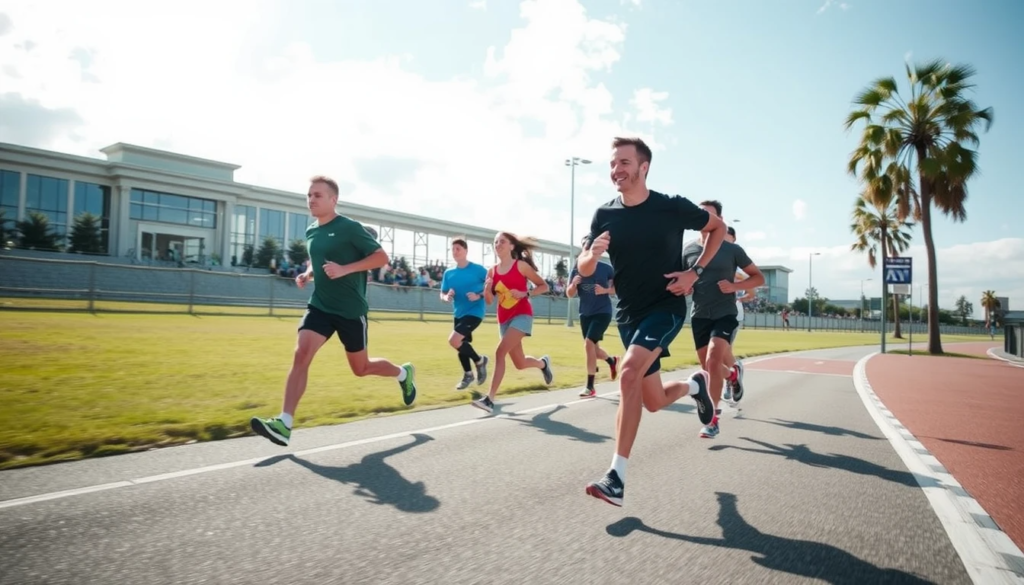Every fitness journey starts with a single step. But what if that step leads to unexpected pain? I’ve been through the tough world of exercise safety and know the pain of injuries. Your body is amazing, and keeping it safe is key.
Injury prevention is more than avoiding pain. It’s about building a fitness routine that lets you reach your goals safely. Whether you’re new to fitness or have been doing it for years, knowing how to stay safe is important.
Your workout should make you stronger, not hurt you. By using smart injury prevention methods, you can lower risks and reach your full fitness. This guide will show you how to keep your body safe and your fitness goals in sight.
Key Takeaways
- Understand the importance of gradual progression in your fitness routine
- Learn proper form and technique to prevent workout-related injuries
- Recognize the value of rest and recovery in injury prevention
- Develop a balanced approach to exercise that includes strength and flexibility
- Listen to your body and avoid pushing beyond your current fitness level
Understanding Exercise-Related Injuries and Their Impact
Sports injuries are a big worry for anyone trying to stay fit. Every year, about 25% of all injuries seen in emergency rooms are from sports. This shows how important it is to prevent injuries and stay aware.
Knowing about sports injuries helps keep your body safe and your workout schedule on track. Overuse injuries, which make up about 50% of all sports injuries, are common and often can be avoided.
Types of Sports Injuries
- Muscle strains
- Ligament sprains
- Joint inflammation
- Tendonitis
- Stress fractures
Common Risk Factors
There are several main reasons why sports injuries happen:
- Improper warm-up techniques
- Poor exercise form
- Muscle imbalances
- Overtraining
- Inadequate recovery time
Impact on Fitness Goals
Injuries can really set you back in your fitness goals. Eating a diet that supports joint health and getting proper rehabilitation can help you recover faster.
“Prevention is always better than cure in sports and fitness.” – Sports Medicine Expert
| Injury Prevention Strategy | Potential Benefit |
|---|---|
| Proper Form Correction | 50% Reduced Injury Risk |
| Physical Therapy | 30-50% Faster Recovery |
| Regular Stretching | Improved Flexibility |
By understanding these points, you can make your fitness routine safer. This way, you can avoid injuries and reach your full fitness goals.
Essential Pre-Workout Safety Measures
Getting your body ready for exercise is key to avoiding injuries. Your pre-workout routine should include warm-up exercises. These exercises get your muscles and joints ready for hard physical activity.
“A proper warm-up is the foundation of a safe and effective workout routine.” – Sports Medicine Experts
Good warm-up exercises boost blood flow, improve muscle flexibility, and lower injury risk. Here’s how to stay safe before working out:
- Dynamic stretching techniques that activate multiple muscle groups
- Mobility exercises targeting specific workout muscle zones
- Progressive movement patterns that mimic your planned exercise
Different workouts need different warm-ups. For example, strength training and cardio workouts require different exercises. Your warm-up should get your body ready for the challenge ahead.
| Workout Type | Recommended Warm-Up Duration | Key Stretching Focus |
|---|---|---|
| Strength Training | 10-15 minutes | Full-body dynamic stretches |
| Cardio Exercise | 5-10 minutes | Lower body mobility exercises |
| High-Intensity Interval Training | 15-20 minutes | Complex movement patterns |
It’s important to listen to your body during warm-ups. Start slow and build up. This helps you catch any muscle tightness or discomfort before your main workout.
The Role of Proper Form and Technique
Functional training needs precise exercise execution. Your safety in workouts depends on correct form and technique. Wrong movements can turn a good exercise into a risk for injury.
Learning the right technique is key to avoiding injuries and getting the most out of your workouts. Virtual personal training has changed how we learn and track correct movements. Live sessions provide instant feedback on your form.
Correct Posture Fundamentals
Proper body alignment in exercises involves several important points:
- Keep your spine neutral during strength training
- Engage core muscles for stability
- Distribute weight evenly
- Maintain controlled breathing
Common Form Mistakes to Avoid
Athletes often make technique errors that risk their safety:
- Arching back during weightlifting
- Incorrect knee alignment in squats
- Rushing through repetitions
- Neglecting full range of motion
Equipment Usage Guidelines
| Equipment | Safety Recommendation | Workout Tracking Tip |
|---|---|---|
| Free Weights | Start with lighter weights | Log repetitions and form quality |
| Resistance Bands | Check for wear and tear | Monitor tension progression |
| Weight Machines | Adjust seat and settings properly | Record machine settings |
“Precision in movement creates strength in performance.” – Fitness Expert
By focusing on proper technique, you’ll lower injury risks and improve your fitness journey. Virtual training platforms now offer detailed workout tracking to help improve your technique.
Injury prevention Fitness nutrition Hydration foods Fitness apps Virtual fitness
Your fitness journey is more than just exercise. Nutrition and hydration are key to avoiding injuries and improving workouts. Learning how to fuel your body and using technology can change your fitness experience.
“Proper nutrition is the foundation of injury prevention and peak athletic performance.” – Sports Nutrition Expert
Virtual fitness has changed how we work out. Now, 73% of millennials use virtual fitness platforms. Fitness apps help track progress, check form, and prevent injuries.
Key Nutrition and Hydration Strategies
- Consume hydration foods rich in electrolytes
- Maintain proper fluid balance before, during, and after workouts
- Use fitness apps to track nutritional intake
- Monitor workout intensity through virtual fitness platforms
Staying hydrated is vital for athletes. Research shows even 2% dehydration can hurt endurance. The National Athletic Trainers’ Association suggests drinking 500-600 ml of water 2-3 hours before exercise. Then, drink another 200-300 ml 10-20 minutes before your workout.
Virtual Fitness Technology
Modern fitness apps offer AI coaching and tailored workouts. With internet streaming and flexible routines, virtual fitness is more accessible than ever.
Smart Training Progression and Recovery Strategies
Developing a smart approach to training can change your fitness journey. It’s key to progress safely and recover well for long-term success and injury prevention.
Pushing your limits needs a strategic recovery plan. Your body must be managed to avoid overexertion and injuries.
Building Workout Intensity Safely
When increasing workout intensity, keep these strategies in mind:
- Start with baseline fitness assessments
- Implement gradual progression techniques
- Listen to your body’s signals
- Use muscle recovery supplements strategically
“Too much, too soon” is a recipe for injury. Smart athletes know the value of measured progress.
Essential Recovery Protocols
Eating for energy is vital in your recovery. Your nutrition affects muscle repair and performance.
Key recovery techniques include:
- Proper hydration
- Targeted muscle recovery supplements
- Adequate sleep
- Active recovery days
AI-powered fitness tools can track your recovery. About 75% of users regularly review their progress. These tools offer insights into your body’s readiness for intense training.
By using these smart training and recovery strategies, you’ll improve your fitness journey. You’ll also lower injury risks.
Warm-Up and Cool-Down Protocols
Getting your body ready for exercise is key to avoiding injuries and boosting performance. Warm-up and cool-down routines are vital for a safe and effective workout. Studies reveal that up to 70% of injuries from exercise can be avoided with the right warm-up and cool-down.

Your warm-up should include mobility exercises to increase blood flow and get your muscles ready for hard work. Experts in functional training suggest doing 5-10 minutes of dynamic stretching. This type of stretching imitates the movements you’ll do in your workout.
- Dynamic stretching improves flexibility by up to 20%
- Reduces muscle strain risk by 30%
- Enhances overall workout performance
Cool-down routines are just as important. Static stretching exercises help your body return to a resting state, reducing muscle soreness and improving flexibility. Research shows that those who cool down regularly experience 20% less muscle fatigue.
“Warm-up and cool-down are not optional – they’re essential for safe and effective exercise.” – Fitness Research Institute
| Exercise Phase | Duration | Key Benefits |
|---|---|---|
| Warm-Up | 5-10 minutes | Increased blood flow, muscle preparation |
| Cool-Down | 5-10 minutes | Muscle recovery, reduced soreness |
By spending time on proper warm-up and cool-down routines, you’ll lower injury risk and enhance your fitness journey. Remember, a few extra minutes can greatly improve your workout’s effectiveness and your long-term health.
Equipment and Gear Safety Guidelines
Keeping safe during workouts begins with the right gear. Your safety depends on choosing wisely to support your fitness and avoid injuries.
The right gear can lower injury risks. Fitness wearables and apps give real-time feedback on your performance and form.
Choosing Appropriate Workout Gear
When picking out workout equipment, keep these points in mind:
- Look for a proper fit for comfort and support
- Choose materials that match your exercise type
- Opt for breathable, moisture-wicking clothes
- Make sure it works with online training apps
Moisture-wicking clothes, like those made from polyester, help keep you dry. Good running shoes are key to avoiding foot pain and injuries.
Maintenance and Replacement Tips
Regular care of your gear keeps it working well:
- Check shoes every 300-500 miles for wear
- Swap out workout clothes when they start to stretch or break down
- Clean fitness wearables often to keep sensors accurate
- Inspect protective gear before each use for damage
“Investing in quality gear is investing in your personal safety and fitness journey.”
Focus on equipment safety and use modern apps and wearables. This way, you can train safer and more effectively.
Strength Training Safety Principles
Strength training can change your fitness journey. Knowing the basics of exercise safety is key. It helps you build muscle safely and avoid injuries.
“Proper technique is the foundation of effective strength training” – National Strength Conditioning Association
Functional training has changed how we build muscle. Your workout should aim to work all muscles and improve skills gradually.
- Target all major muscle groups
- Use correct form during each repetition
- Implement gradual weight progression
- Allow adequate muscle recovery time
Nutritional supplements are important for strength training. Protein powders, creatine, and amino acids help with muscle recovery and growth.
| Training Frequency | Recommended Sessions |
|---|---|
| Beginner | 2-3 sessions per week |
| Intermediate | 3-4 sessions per week |
| Advanced | 4-5 sessions per week |
Studies show that just two to three 20-30 minute strength training sessions weekly can greatly improve muscle strength and bone density.
Important safety tips include warming up, using the right weights, keeping the right posture, and listening to your body.
Cardiovascular Exercise Safety
Cardiovascular exercise is key to staying fit, but safety comes first. Thanks to fitness apps and online training, it’s easier to keep an eye on your workout intensity.

About 50% of adults in the U.S. face risks for heart disease. Knowing how to monitor your heart rate and manage intensity is vital for your fitness journey.
Heart Rate Monitoring Strategies
Keeping an eye on your heart rate during exercise prevents overdoing it and health risks. Modern fitness apps have advanced tools to help you:
- Monitor real-time heart rate zones
- Calculate maximum heart rate based on age
- Track workout intensity
- Provide personalized hydration tracking recommendations
Managing Exercise Intensity
Slowly increasing workout intensity can cut injury risks by up to 50%. Online training platforms help you build a safe, step-by-step cardiovascular routine that fits your level.
“Listen to your body and modify workouts to avoid injury.”
Using technology and expert advice, you can design a safe, effective cardiovascular plan. This supports your fitness goals for the long haul.
Environmental Considerations for Safe Workouts
Your workout environment is very important for staying fit and safe. Knowing how the outside world affects your exercise is key. It helps you stay hydrated and safe while working out.
“Environment is everything when it comes to workout safety and performance.” – Fitness Expert
Drinking enough water is very important for safe exercise. Our bodies are mostly water, so we need to drink a lot when we’re active. Even a little dehydration can hurt how well you exercise.
Hydration Guidelines
- Drink 16-32 ounces of water per 30-60 minutes during exercise
- Consume 2-3 cups of fluid two hours before working out
- Replace each pound of body weight lost with 24 ounces of water post-workout
Virtual workout programs and online yoga classes are great for staying active. They let you work out in a safe place and avoid bad weather. You can also keep a regular workout schedule.
- Exercise in a controlled indoor setting
- Minimize exposure to extreme weather conditions
- Maintain consistent training schedules
Hydration and Performance Metrics
| Hydration Level | Performance Impact | Recommended Action |
|---|---|---|
| 2% Body Weight Loss | Performance Impairment | Increase Fluid Intake |
| 5-6% Body Weight Loss | Significant Performance Decline | Immediate Rehydration Required |
By understanding these environmental factors, you can make your workouts safer. You can use virtual fitness options and stay hydrated. This way, you can perform at your best.
Professional Guidance and Support Systems
Finding your way in fitness is more than just staying motivated. Getting help from experts can change your workout for the better. It helps avoid injuries and gets you better results. Online personal training makes it easy to get support from home.
Professional trainers teach you how to exercise safely. Virtual personal trainers and AI fitness coaches are key for those looking for expert advice.
Benefits of Professional Training Support
- Personalized workout plans tailored to your fitness level
- Expert form correction and technique analysis
- Injury prevention strategies
- Customized nutrition and recovery recommendations
When to Seek Professional Advice
Knowing when to ask for help is important. It keeps you safe and helps you reach your fitness goals. Here are times when you should get professional advice:
- Starting a new exercise program
- Recovering from a previous injury
- Experiencing persistent pain during workouts
- Wanting to improve athletic performance
“Professional guidance transforms good intentions into sustainable fitness success.”
Medical Consultation Indicators
| Symptom | Action |
|---|---|
| Acute or chronic pain | Immediate medical consultation |
| Unusual fatigue | Consult healthcare provider |
| Limited mobility | Seek professional assessment |
Using online personal training can make your workouts safer and more effective. It’s tailored to your needs and goals.
Conclusion
Your fitness journey is more than just working out. It’s about preventing injuries through healthy eating, smart training, and new fitness tech. Studies show digital health tools and nutrition apps can make your workouts better and safer.
Hybrid gym memberships offer a new way to stay fit. They give you flexibility and personal support. With AI and smartwatches, you can track your health better. These tools spot mistakes and offer tips to avoid injuries, making your workouts safer and more effective.
While injuries can happen, the right strategies can lower your risk. Focus on proper form, know your limits, and use digital health tools. Good nutrition is also key for performance and recovery.
Your fitness journey is special. Use a mix of tech, nutrition, and careful training to create a strong workout plan. Stay curious, informed, and committed to your health.




